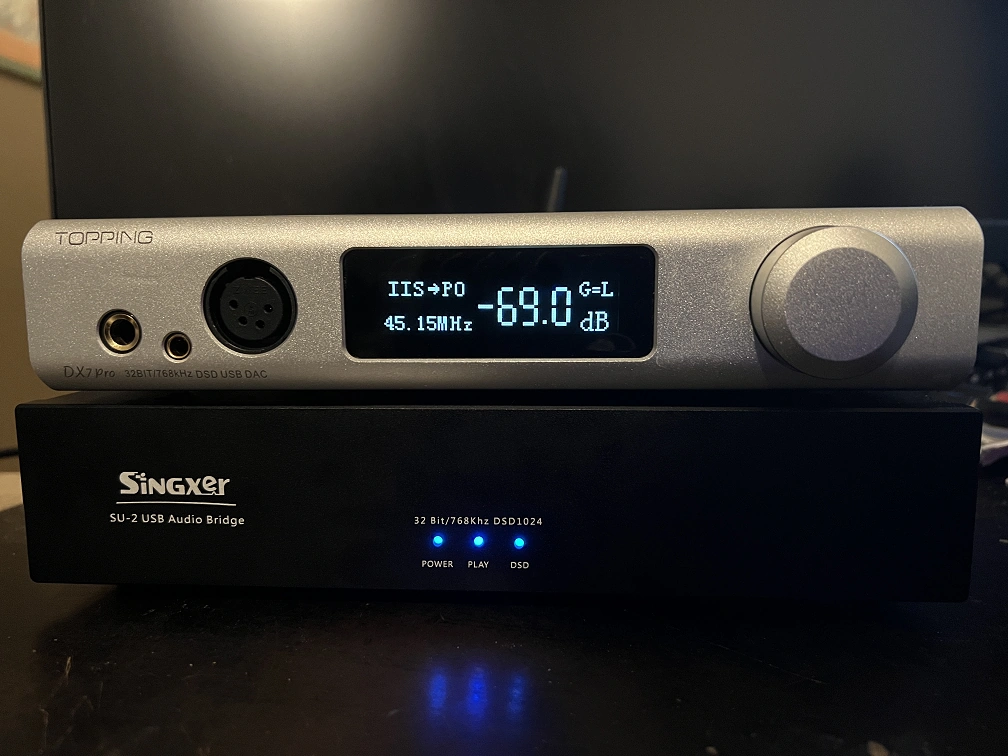| 4 minutes
Recently, I ended up buying a Singxer SU-2 out of curiosity since I wanted to hear how I²S and DSD1024 sound. It did also free up the DX7 Pro’s USB input for use with another computer, but that could be solved in so many other ways. As much as I would have liked it to be, it was not all smooth sailing to fully experience this setup, and in this post I will detail the steps I took to make it work.
Getting the DX7 Pro to recognise a DSD1024 signal
I wasn’t expecting it to be a perfect plug-and-play experience, after all with I²S over cable being non-standardised you do need to configure the devices with matching settings. The DX7 Pro uses the same pinout as Gustard devices, so just follow those instructions in the SU-2 handbook. Now, you might expect that just matching I²S settings was enough, but no! The second I attempted to play DSD1024, I was met with silence. The DX7 Pro was not picking up any signal.
After 30 minutes of frustration, it turns out that in order for the DX7 Pro to pick up a DSD1024 signal, option #8 “DAC Mode” must be set to syncronous (SYNC) mode in the settings menu accessible by holding down the volume knob button while powering the device up. Now DSD1024 is recognised and plays… with an earrape of terrible static on top of the music. Now this is where I spent at least another 1.5 hours just banging my head against a wall. This is such a niche problem that nobody else on the internet had encountered this problem with my specific devices, so I was forced to do original research.
The quest and solution for clean playback
I quickly ruled out DSD hardware decoding and software issues, since every other DSD rate was playing perfectly from an appropriately configured Foobar2000 and Roon. I also tested Signalyst’s HQPlayer Desktop software as it is known for having high quality filters and modulators, and it showed the same problem. After nearly giving up, I remembered that it has these “AMSDM7 512+fs” and “AMSDM7EC 512+fs” modulators which are “Special adaptive seventh order ‘pseudo-multi-bit’ modulators optimized for rates above >= 20.48 MHz”, whatever that means. Thinking I had nothing to lose, I turned down the volume yet again, selected the “AMSDM7 512+fs” modulation, started playback… and it sounded perfect! Not an ounce of static or distortion, just pure music. Finally!
TL;DR solution: Use Signalyst HQPlayer Desktop with the “AMSDM7 512+fs” or “AMSDM7EC 512+fs” modulator, though in my experience the EC one is unusable for real-time playback even on a 5950X. If you have HQPlayer Pro, you can save the specially modulated output to a file which will then play perfectly with Foobar2000 or other compatible players without extra processing overhead.

Bonus review: what do I think of all these things?
DSD1024
DSD1024 sounds good, just like any other lossless format will. Perhaps some other equipment has different processing that makes it sound better, but with mine I can’t tell any difference to other DSD rates or even CD quality PCM audio. It is very large on disk and can be problematic to play as demonstrated in this very post, so I wouldn’t recommend collecting music released in the format for most people, but no harm in trying it out.
Singxer SU-2
The SU-2 did not cause any obvious improvements or regressions at least to my ears, so I can recommend it if you have a use for it.
I²S over HDMI
External I²S seems like a solution looking for a problem. Amir over at Audio Science Review did some measurements here, to sum it up there doesn’t seem to be any meaningful benefit in using it, unless it for some reason performs better with specific equipment.
Topping DX7 Pro
The DX7 Pro always sounded great, and is a great buy if you have a use for all its connectivity and format support, or if you just plain want something like it.
Updates
Some rewording in I²S review section, as I didn’t like how absolute it sounded before. (2022-03-31)